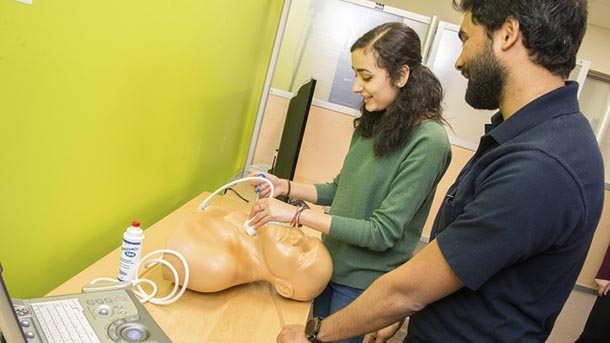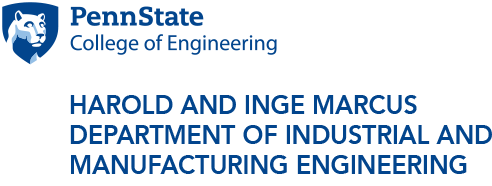
Penn State industrial engineering student Rucha Bhide, left, and graduate student Rohan Prabhu work in the Brite lab to develop a more effective training procedure for central venous catheters.
Scholar part of research team working to improve medical training
2/28/2018
UNIVERSITY PARK, Pa. — Some medical procedures are best learned by doing. But practicing those procedures on real-life patients in distress is far from ideal.
Schreyer Scholar and industrial engineering major Rucha Bhide is working with a team of Penn State researchers to find ways for resident physicians to learn central venous catheter placement by analyzing their gaze patterns using a dynamic haptic robotic trainer.
"The biggest goal of this project is to find the most efficient way to learn," Bhide said. "We're trying to see if there's a way to increase their rate of learning and decrease the mistakes they're making and give them the most amount of practice before they go onto a real patient."
Bhide is working in the Brite lab with Scarlett Miller, associate professor of engineering design and industrial engineering, who is part of a group of Penn State researchers that includes Jason Moore, associate professor of mechanical and nuclear engineering, and Penn State Hershey vascular surgeon Dr. David Han. They have been developing the robotic trainer and comparing its effectiveness to previous methods, including use of a manikin and observation of another physician performing the procedure.
"The manikin system that they currently use only allows you to practice one thing over and over again," Miller said. "And there's a lot of tells. You can see where it's been punctured in the past, so you know where to put it. And there's only one patient profile and it's not very accurate."
The robotic trainer uses a variety of patient profiles — modifying thickness of the skin, amount of fat tissue, and other variables — and measures feedback using six different areas of interest. The screen tracks where the resident's eyes are looking as he or she is going through various points of the procedure.
"I'm trying to see what's the most useful thing to put on that screen," Bhide said, "and if there's redundant information that they don't use, we consider taking that off, and then based on the survey booklets, adding something else to the screen that would be more useful in their learning."
Expert surgeons also have provided oral feedback on the robotic trainer. The research study funded by the National Institute of Health has potential applications to other ultrasound-guided procedures. So far, the data has shown the robotic trainer is working.
"Basically, we know they're getting better," Miller said, "but we want to see if it can improve the learning system or if there are aspects of it that are key for improving medical curriculum."
Bhide has a job as a consultant with IBM lined up after she graduates in May. She said she has gleaned confidence from both the personal relationships she has developed with her professors and from her peer group in the Schreyer Honors College.
"Schreyer gave me a really good resource and community," she said. "It's made Penn State a lot smaller and a lot more manageable."



